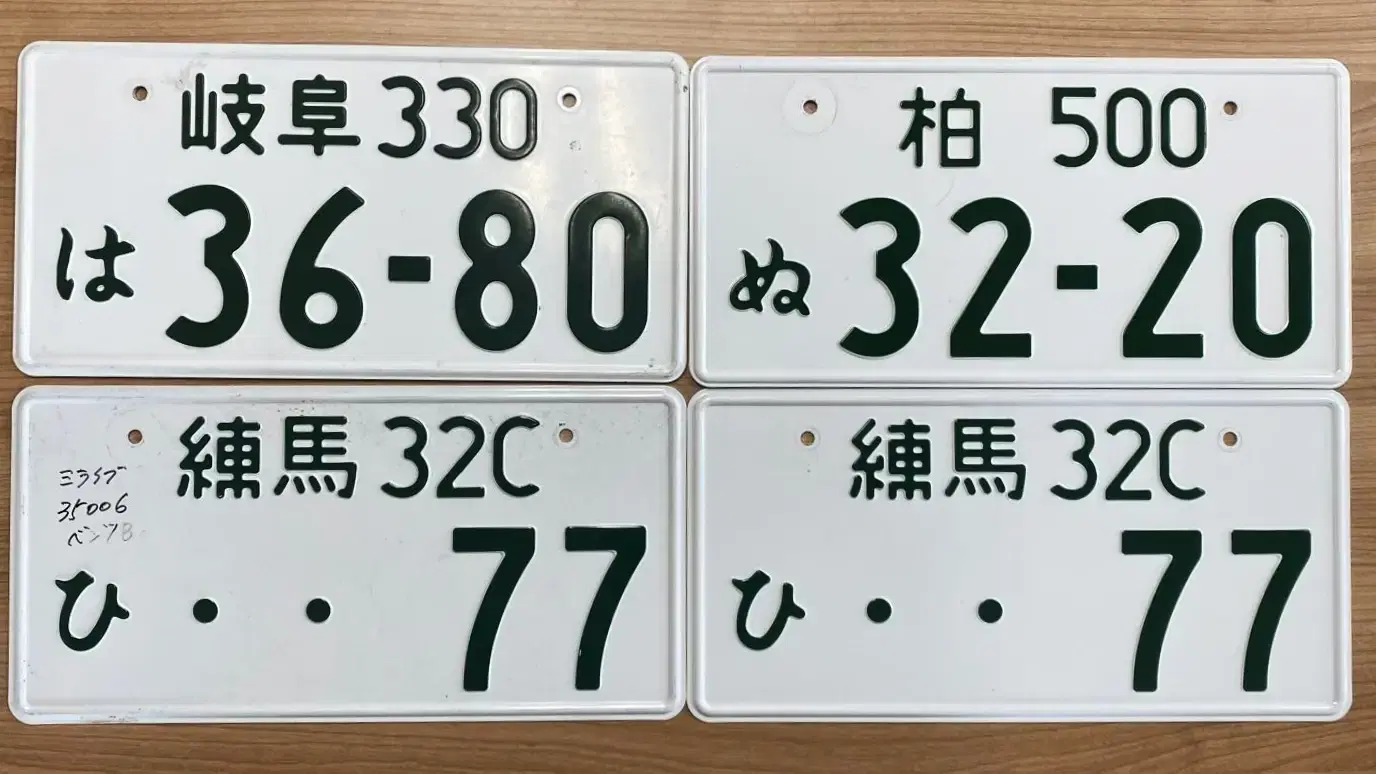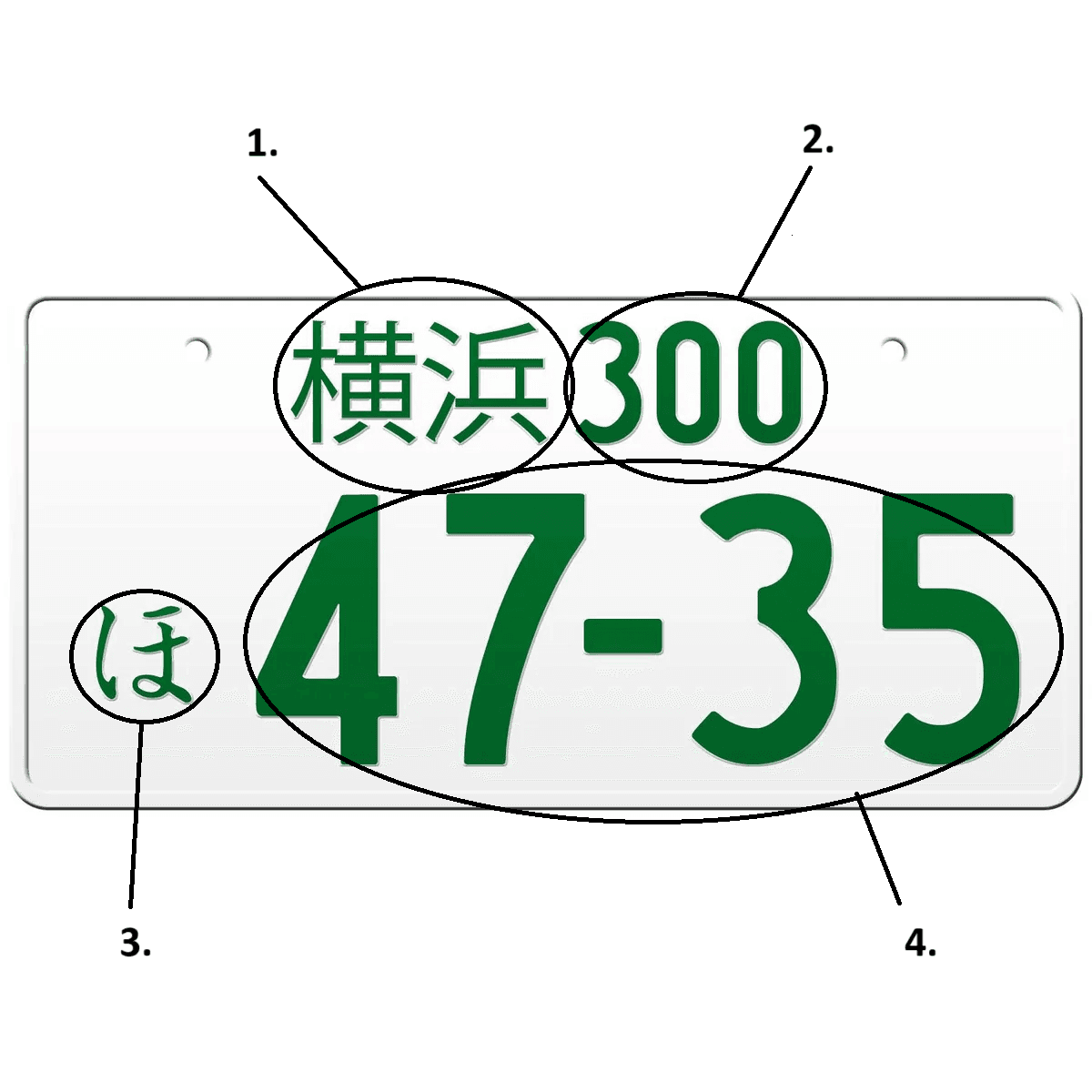Everything about Japanese License Plates
Kisal Walpola
Posted 22 August 2024

Japan's license plates are a fascinating blend of functionality, regional identity, and cultural significance. Serving the practical purpose of vehicle identification, the design and structure of these plates reflect various aspects of Japanese society. This article delves into the design, significance, and regulations surrounding Japanese license plates, providing a comprehensive understanding of their unique characteristics.
Design and Structure
Japanese license plates are rectangular, typically measuring 330 mm by 165 mm for passenger vehicles. Made of aluminum, they feature a combination of kanji characters, numbers, and hiragana characters. The plates are color-coded based on the type of vehicle, with private vehicles having a white background with green characters, while commercial vehicles have a yellow background with black characters. Diplomatic and foreign-registered vehicles have their unique color schemes, which further distinguish them from the rest.

Key Elements of a Typical Japanese License Plate
- Prefecture and Office Code: The top line of the plate displays the name of the issuing prefecture in kanji, followed by a numerical code representing the vehicle registration office. This code helps identify the specific location where the vehicle is registered.
- Class Number: The number on the top line is a vehicle class code which begins with a 0 through 9 to indicate specific vehicle classification. This is signified by the length, width and height as well as the engine displacement.
- Hiragana Character: Below the prefecture name is a single hiragana character, indicating the type of vehicle. This character helps distinguish between different classes of vehicles, such as rental cars, private cars, and company-owned cars.
- Registration Number: The main portion of the plate consists of a four-digit number. This number is unique to each vehicle within its category and region. If the registration number exceeds four digits, a hyphen is placed in the middle, ensuring clarity and readability.
Regional Identity
Japan is divided into 47, each with its unique identity reflected in its license plates. This regional pride is often displayed through special regional plates, featuring local symbols or landmarks. For instance, Okinawa's plates may include an image of the Shuri Castle, while those from Hokkaido might depict the region's iconic landscapes. These special plates not only serve as a point of pride for residents but also promote tourism by showcasing local attractions and cultural heritage.
Prefecture-Specific Features
Each prefecture's license plate design is carefully chosen to represent its identity and cultural significance. In Tokyo, for instance, the plates might feature symbols associated with the city’s vibrant urban life. In contrast, a prefecture like Kyoto, known for its historical temples and traditional culture, might incorporate elements of its rich heritage.

Regulations and Categories
The Japanese license plate system categorizes vehicles into several types, each with its specific regulations and requirements:
- Private Vehicles: These are the most common type of license plates, designated for personal use. They have white backgrounds with green characters. Private vehicles range from small cars to luxury sedans, and their registration process involves specific taxes and fees based on the vehicle's size and engine capacity.
- Commercial Vehicles: Used for business purposes, these plates have yellow backgrounds with black characters. Commercial vehicles include taxis, delivery trucks, and buses. They are subject to different regulations, including higher taxes and more stringent inspection requirements to ensure safety and reliability for commercial use.
- Light Vehicles (Kei Cars): These are smaller, more economical cars with engine sizes up to 660cc. They have yellow plates with black characters and are subject to lower taxes and insurance costs. Kei cars are incredibly popular in Japan due to their affordability and practicality in crowded urban environments.
- Diplomatic and Foreign Vehicles: Diplomatic vehicles have blue plates with white characters, while foreign-registered vehicles have white plates with black characters. These plates have specific codes indicating their status, ensuring that these vehicles are easily recognizable and granted the appropriate privileges and exemptions.
- Temporary and Test Plates: Temporary plates, used for short-term purposes like moving an unregistered vehicle, have a distinctive red diagonal stripe. Test plates, used by manufacturers for road testing, feature red characters on a white background. These plates are strictly regulated to ensure they are used appropriately and only for the intended temporary purposes.
Special Plates and Personalization
In addition to standard plates, Japan offers several special plates. Personalized plates allow vehicle owners to choose specific numbers, often for an additional fee. These personalized numbers are subject to availability and certain restrictions, providing a unique touch to the vehicle while adhering to regulatory guidelines.
Commemorative Plates
Another popular category is the commemorative plate. These plates are issued to celebrate significant events or anniversaries and often feature unique designs and colors. For instance, plates issued for the 2020 Tokyo Olympics featured special logos and designs, serving as both a functional license plate and a collector's item. Commemorative plates are a way for vehicle owners to participate in national pride and celebrate important milestones.
Personalized Plates
Personalized plates in Japan are a relatively new concept but have quickly gained popularity. Vehicle owners can select specific combinations of numbers that hold personal significance, such as birthdays, lucky numbers, or memorable dates. The process of obtaining a personalized plate involves checking the availability of the desired combination and paying an additional fee. Personalized plates add a unique and individualistic touch to the vehicle, reflecting the owner's personality and preferences.

Technological Advancements
Japan is at the forefront of integrating technology into its license plates. Some modern plates feature IC chips that store vehicle information, aiding in toll collection, traffic management, and law enforcement. These smart plates aim to improve efficiency and security on the roads, aligning with Japan's reputation for technological innovation.
Smart Plates and Their Benefits
Smart plates with embedded IC chips offer numerous benefits. They facilitate automatic toll payments, reducing the need for physical toll booths and streamlining traffic flow. Additionally, these plates can assist in vehicle tracking and stolen vehicle recovery, enhancing security. The data stored on the IC chips can also be used for traffic analysis and urban planning, contributing to more efficient and safer road systems.
Conclusion
Japanese license plates are more than just vehicle identifiers; they are a window into the country's culture, regional pride, and technological advancement. Their design, categorization, and regulation reflect meticulous attention to detail, characteristic of Japanese society. From the distinct hiragana characters and prefecture symbols to the innovative use of technology, Japanese license plates offer a unique and insightful perspective on how a simple object can embody a nation's values and identity.
Whether you are a car enthusiast, a traveler, or someone interested in cultural nuances, the world of Japanese license plates provides a rich tapestry of information and visual delight. The plates not only fulfill their primary function of vehicle identification but also serve as a medium for cultural expression and technological progress. The next time you see a Japanese license plate, take a moment to appreciate the intricate design and the story it tells about its origin and purpose.